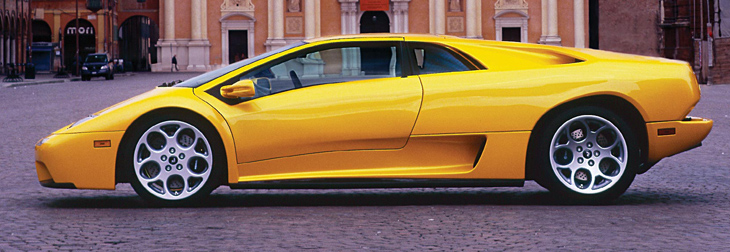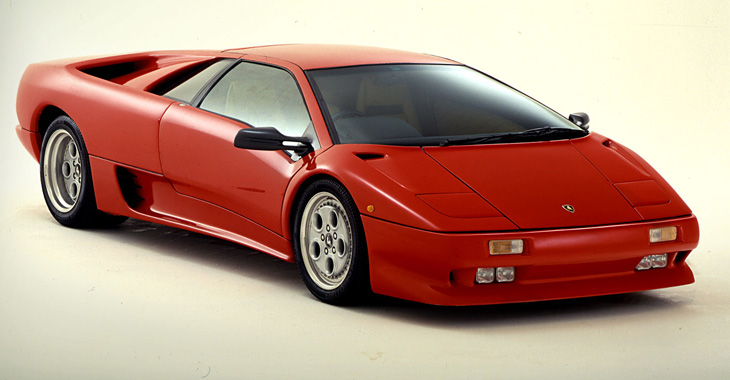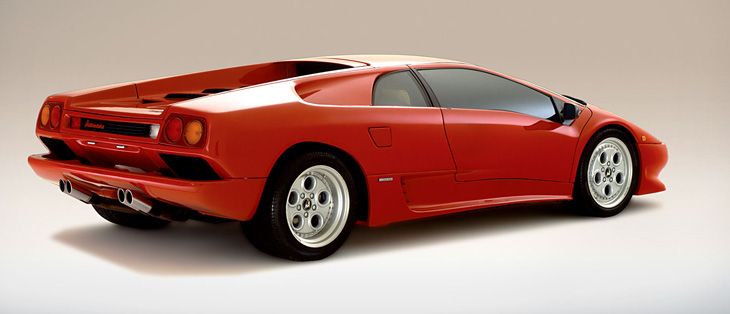|

1987 to 1994 Lamborghini Motorcar History
On 23 April 1987, 'Nuova Automobili Lamborghini SpA' was taken over by the US Chrysler company.
The American owners quickly settled in at Sant'Agata and a period of intense activity began, this time in close collaboration with a major automotive industry. The premises were good, although there were a few
false steps at the beginning: the prototype of the Portofino. Production of the Quattrovalvole series stopped in 1988, with a total of 631 units. In the meantime, the company gained experience with composite materials
and a special Countach, the Evoluzione, demonstrated the full potential of this project. Weight reduction permitted by these new materials, coupled with a more powerful engine achieved above all using new engine
technologies management, offered extraordinary performance. Unfortunately, however, the Evoluzione never went into production.
Towards the end of 1987, the French Formula 1 team Larrousse asked Mauro Forghieri, the celebrated designer of Ferrari's finest models from the Sixties and Seventies, to create a new engine, and he turned to
his good friends at Lamborghini with the proposal of embarking on the project together. After obtaining Chrysler's approval, Forghieri designed his engine, a V12 with a 3.5-litre capacity, the maximum displacement
allowed by regulations. Ready within a matter of months, the new engine was officially demonstrated to the public in April 1988.
As a result, even a titled team like Lotus requested Lamborghini engines for the following season. Thanks also to this double supply of engines to two teams, the results for 1990 were nothing short of brilliant. At the end
of the British Grand Prix, Bernard won an extraordinary fourth place and Suzuki placed sixth. The Hungarian Grand Prix was even more rewarding for the Lamborghini engines, which placed fifth, sixth and seventh,
respectively with Warwick (Lotus), Bernard (Larrousse) and Donnelly (Lotus). Nevertheless, the best placement of the whole season came from Suzuki on his home turf at the Grand Prix in Japan, as he placed
third and gave the company its first podium finish. This was the best placement ever achieved by a Lamborghini engine in all its seasons of activity.
Despite Forghieri's commitment, the American company's insensitivity to the financial problem led to a progressive decline in automotive performance and the 1991 season ended negatively, with the definitive
withdrawal of the Modena F1 Team from the world championship. Now this lovely single-seater can also be admired at the Sant'Agata museum, and it represents one of the most important missed opportunities in the
history of Lamborghini.
In the meantime, Lamborghini managed to make significant progress in renewing its model range of road
vehicles. In order to celebrate the company's twenty-fifth anniversary, a commemorative version of the Countach was produced. The Anniversary was the praiseworthy final version of this glorious car, and
needless to say, it was welcomed enthusiastically by customers, who purchased no less than 657 units. The Countach's successor was presented in 1990. The 132 was dubbed the Diablo, the name of a particularly
fierce fighting bull of the nineteenth century, and it proved to be up to expectations. The Countach's follower could not be a conventional car, of course, and it had to be extreme, spectacular, forceful and
uncommon: the Diablo, with its 492 hp generated by a 5.7-litre V12, was all this - and more.
Its designer is Luigi Marmiroli. In 1990, the Diablo was presented in the two-wheel drive version, but a
four-wheel drive version was already in the wings, and from that point on this would become a distinctive feature of the top Lamborghinis. This version, named the Diablo VT for 'Viscous Traction', given the presence
of a viscous coupling between the front and rear axles, was presented at the Geneva Motor Show in March 1993.

1990 Lamborghini Diablo - The supercar of the future
1990 – The Diablo was destined to become the worthy heir of the renowned Miura and Countach. This new
supercar was wide, low and futuristic. And just like its predecessors, the Diablo soon became a favorite among car enthusiasts across the world.
The Lamborghini bosses had wished for a maximum speed of at least 320 kph, and the engineers made this wish come true: With a top speed of 325 kph and an acceleration from 0-100 in 4.5 seconds the Diablo
claimed the pole position in the super sports cars segment.
It delivered its power via a rear-wheel drive and came with a newly developed V12 engine. Four valves per
cylinder, a computer controlled multi-point fuel injection and a displacement of 5.7 liters helped produce a maximum of 492 HP.
The Diablo was produced between 1990 and 2001. During this period, Lamborghini introduced several variations of the Diablo concept, the first being the Diablo VT (Visco Traction), which featured an all-wheel drive.
he Diablo models helped build the legend of Lamborghini and sold well. Almost 3,000 units across all series and variations found their buyers in those eleven years of evolution.

|